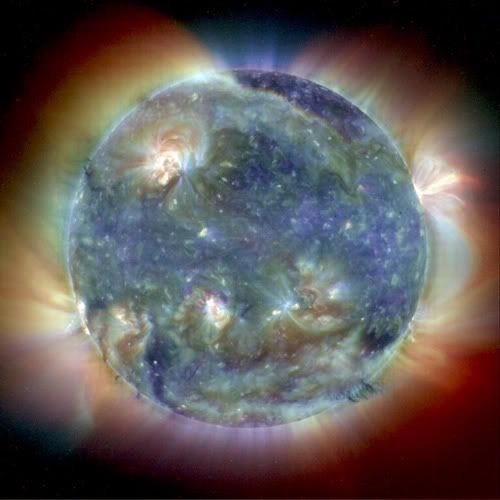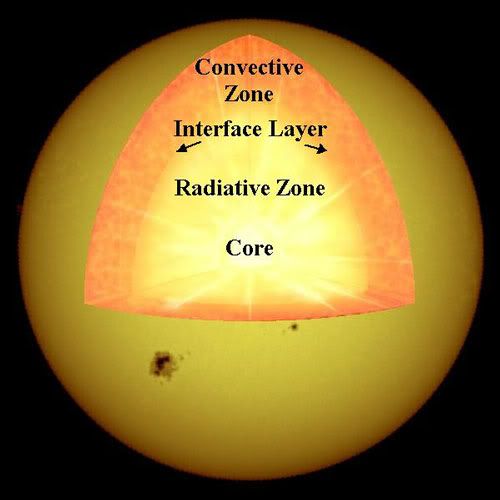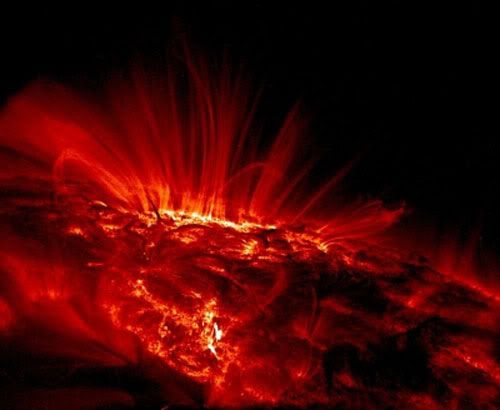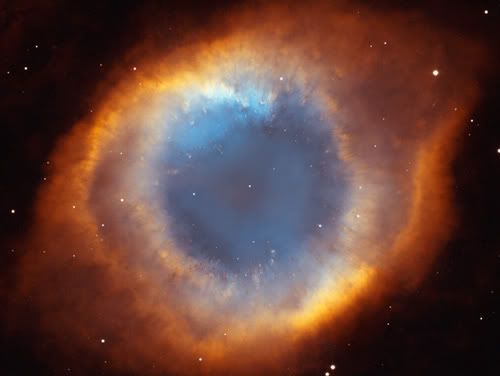
We delight in the warmth of our sun after a long winter or days on end rain. In spring we smile at the first sign of our gardens coming back to life, the return of the migrating birds, the sounds of frogs, toads and crickets and our hearts quicken to examine what else is peaking through the soil. Trees turning from that grey bare haunted appearance to the sprouting of the most beautiful and colourful blossoms.
The Sun is the most powerful source in our solar system. It generates the heat and life that sustains us, without the sun we wouldn’t have life, as we know it, here on earth. But the sun is volatile and dangerous and it’s becoming more dangerous. It will become hotter as it ages, evaporate our oceans, melt the surface of our planet and make any life on earth impossible.
Understanding our sun
The sun’s core is a massive thermo-nuclear reactor. Five million tons of hydrogen fuse into helium every second and temperatures exceed 15mil°C. Under the enormous pressures gases become as dense as solid led. This is Einstein’s famous formula E=mc² pure glowing energy. Every second, almost six hundred million tons of hydrogen are converted into helium, that’s more energy in one second than six billion nuclear power plants would produce in a year.
The incredible journey that photons make from the centre of the sun’s core to reach the earth were created over millions of years ago and some were starting their journey when dinosaurs were still enjoying and reigning master on our earth.
Imagine a Russian doll and when you open it there are still more dolls to open, this is the dynamo of our sun with intricate layers inside. In the sun’s dense core photons zoom around at the speed of light bumping into electrons. As they collide, photons pass on energy or momentum just as one ball hits another one and gives momentum to the second ball. The same as when we were kids in school and during recess we played with marbles, flicking one marble into a bunch of other marbles, watching with anticipation as one gives momentum to the other one where then the other marble bumps into yet another marble and gives momentum to that one and so on. The next obstacle within this Russian doll is the radiative zone; here photons are bounced around by particles of hot hydrogen gas called plasma. They start changing directions in random ways a bit more like in a pinball machine, zigzagging around for years and years and years and years. Some reach the next dynamo of the Russian doll called the convection layer where they are absorbed in rivers of hot searing gas and carried by their currents to the sun’s surface, the photosphere. Here the hot gases cool and release their energy as photons once more. The photons stream into space and traveling at the speed of light to complete the 93mil journey to earth in just eight minutes.

Where did such an enormous powerhouse come from?
Five billion years ago a massive dying star went super nova, where in its death throes a massive shockwave exploded in space. The shockwave collided with a cloud (called molecular cloud also known as a nebula) of dust and gas in our milky way causing it to implode. Within the spinning disk of interstellar gas, immense gravitational forces crushed hydrogen atoms, super heating them. Nuclear fusion began, the sun was born.
The leftovers cooled and became the planets and meteorites that inhabit our solar system, within them were elements that once existed in their parent star, elements that became the building blocks of life on earth.
Our sun is less than half way through its life, it’s been going for four and a half billion years, and it has less than six billion years left to go. Certainly the sun is not the first star in our galaxy and we have to put it into this broader cosmic context to place it right back to the birth of our galaxy in years earlier to understand how it formed with a particular mix of atoms. When our sun was born it formed already contaminated by the debris from early generations of stars. So this has two fascinating implications, it means to ask the question where the atma before came from, why oxygen is common but gold and uranium are rare. We’d have to think about the fate of stars in the remote parts of our galaxy, which died five billion or more years ago, before our sun was born. So in short everything is inter-connected, our galaxy is like a large eco-system (see Pangaea The Battling Elements – the Rock Cycle) birth – destruction –rebirth. Hence, gases are being recycled from one-generation star after another, and if you are a romantic we are all stardust; and if you are less romantic we are the nuclear waste of earlier generation of stars. It all makes sense doesn’t it?
The sun has sustained and captivated humans since they began to populate the earth. Five thousand years ago the Nubians and the Egyptians worshipped the sun as their god. A thousand years ago the Anasazi people of America edged solar images on the Chaco Canyon walls. With rudimentary astronomy Anasazi’s Sun Priests foretold the rhythm of the sun, when to plant and when to harvest in an unforgiving desert. But strange events were to unfold, in the 11th century a single generation Anasazi were an audience to an extraordinary celestial pageant. In forty years they witnessed Haley’s Comet, two solar eclipses and an exploding star that illuminated the sky for three weeks on end. The devoted sky watchers erected five solar observatories in Chaco Canyon and aligned their cities in the sun’s movements. The Anasazi were well versed in the comings and goings of the sun but of its inner workings they knew nothing.
Four centuries later in 1664 the curiosity of a Cambridge University student lead to a fundamental discovery. His name, Sir Isaac Newton; he concluded that sunlight is composed of a spectrum of colours, red at one end, violet on the other. A spectrum is like a signature it uniquely reveals its author’s hand. The sun emits mostly green and blue light, less are violet and red. That signature reveals the temperature of the visible sun, averaging almost 6,000°, but as it was discovered later, 6,000° was merely the cool part of the sun. In 1929 scientists on an eclipse expedition observed furious fingers of gas streaming hundreds of thousands of kilometres into space; the sun had exposed its tenuous outer atmosphere, the corona. But scientists analyzing its spectrum found temperatures exceeding a million degrees, how could the corona be so much hotter than the sun’s surface? It was a puzzle that is only now beginning to be solved.

Since Galileo Galilei and the invention of the telescope Galileo had observed sunspots on the sun and after having relayed to the Church that the sun had blemishes, he was swiftly ushered to his new accommodations better known as prison for heresy. Galileo was forced to recant to get out of prison and spent the rest of his life in house arrest. But he was right when he said the sun was not pure. Although the sun was a god in the past thousands of years in the pagan religions it still held a high place when Christianity came strong to the fore. Still today if you visit some of the Christian churches the sun is well displayed on ceilings and/or behind some of the statues of the saints. The sun was considered as a pure smooth globe, soft as the finest of silk spun in sparkling gold. Well no, it’s none of those things. It is violent and dangerous. It hiccups, burps and releases gas. Lots of gas. Some bubbles of gas are the size of Texas, the sun experiences hurricanes and shockwaves, tornadoes as big as continents spewing thousands of kilometres of radioactive hot gases into space, known as solar flares and some are so incredibly violent that the exploding gases hurl towards earth and punches into our magnetosphere without apologies, where then we can see the auroras on either side of our poles. These high explosions are called coronal mass ejection (CME). Now that is some exploding gas, no wonder the sun is angry. In 1989 the citizens of Quebec, including myself got a taste of just how angry the sun can be. Power grids got fried and for 9 hours Quebec went into a blackout. The phones pinged; the lights at first went dim, dimmer, and still dimmer and then completely out. The clock on my stove got fried and so did the coffee maker, anything electrical moaned and died including some satellites orbiting our earth. Outside the night skies turned into daylight with a beautiful swirling pink sky similar to that of a belly dancer’s veils moving across the heavens. Some thought this was the end of the world, others were fascinated at the physics of nature and the awareness of the mere mortals that we are, completely helpless at the ravages of nature itself. This was a CME (coronal mass ejection) hurling from the sun towards earth over a million miles per hour. If a CME could do this, imagine what a Super Coronal Mass Ejection could do to our earth, to us, and anything living. Astronomers have observed some stars like our sun and some somewhat bigger have Super Coronal Mass Ejections, we’ve never had them here and thank goodness we haven’t because a SCME would strip away our ozone layers and all living things would be affected with radiation. This would cause our molecules, our DNA inside our bodies to break down within three days and we including living things such as birds, animals, fish and plants would die. When the astronomers first landed on the moon they knew little of the damages solar flares could cause, today on the International Space Station astronomers have a safe zone cabin on board so when they get the alert from Spaceweather that a solar flare is heading their way they seek refuge in their safe zone until it passes. Still even in their safe zone they receive the equation of a thousand X-rays within some minutes. Spaceweather and solar-physicists are vigilant observers for sunspots, CMEs and the sun’s activities.
The sun is a magnetic star, at its birth the sun spun so rapidly it generated enormous magnetic fields. To this day clumps of furious magnetic activity from deep inside the sun erupt onto the surface and become visible as sunspots up to fifty thousand kilometres in diameter. Why they came and went in an eleven-year cycle perplexed astronomers for centuries. At last when SOHO was launched in 1995 solar physicists had the chance to understand the inner workings of the sun and what drives the solar cycle. Beneath the surface two shells nest like those Russian dolls I had previously mentioned, the inner shell of hot gas rotates like a solid ball. Within the outer shell, circulates immense jet streams of electrified hydrogen. The electrified charged layers slide past each other like elements of an enormous dynamo. Somehow they reset the sun’s powerful magnetic field every eleven years to create the solar cycle.
Are you feeling somewhat confused by now? Don’t worry about it even physicists are scratching their heads. Simply put you can say that fusion drives the sun and makes her hiccup, burp and emit gas and sing. Yes the sun sings – smiles.
The Death of our Sun
Our sun is now 4.5 billion years old, it is approaching middle age, but we know little of how a middle-aged sun will behave. Other middle-aged suns vary in their intensities, some become slightly cooler, and some become hotter. Already the earth has felt the effects of similar fluctuations, a mini ice age in the 15th and 16th centuries coincided with a passive sun. Centuries earlier a more active sun is believed to have triggered three hundred years of higher temperatures, long before our industrial age brought global greenhouse warming. Isotopes in polar ice cores suggest the sun is more violent now than it’s been for five or six thousand years. The behaviour of other middle-aged stars suggests our sun could become more violent yet. Since it was born the sun has been consuming itself at the rate of five million tons of hydrogen every second, a fuel starved sun will burn faster and hotter. Within two billion years, higher temperatures here on earth will evaporate the ocean. The planet will be nudged towards a run-away greenhouse condition, considering we didn’t haste its speed with our own activities by causing a run-away greenhouse effect much sooner. Life on earth would have been baked out of existence, yet the sun’s final chapter will have only begun.
Astronomers are well aware of how the sun will die. As they die most stars produce an aluminous ball of gas called a nebula. Like epitaphs nebulas remain suspended in the universe for thousands of years. Only the very largest stars become an exploding super nova, our sun is too small to expire in a blaze of glory. Death will be administered slowly by gravity.
A Red Giant
As the last of the hydrogen in our sun’s core burns the star’s crust will swell, becoming a Red Giant, engulfing Mercury and Venus. From earth the sun would fill a quarter of the earth’s daytime sky. As the star expands gravity weakens its hold, pieces will blow away and drift into interstellar space. At the core, relentless gravity will crush the helium ashes of the ten billion year old firewall with a force so great they will ignite hotter than before. At a hundred million degrees the doomed helium atoms will become first carbon then oxygen. The end is near.
From the cinders a faint glow will emerge, it will mark the graveyard of a star that shed light for ten billion years. Its ashes may be swept up by a passing comet, all that will remain is nuclear waste or stardust.

The Helix Nebula – a sample of how our star will look with its nebula surrounding a white dwarf. If witnessed from another solar system our star will become a white dwarf, giving off a bluish faint light.
To be continued – Global Warming / Global Dimming
Note:* This post The Sun/Global Warming/Global Dimming (and the continuing post)
Is written in answer to a question our friend Viccles had asked on my previous post (Pangaea The Battling Elements)
Have a fantastic weekend and a safe week ahead
TrudiWabbit
No comments:
Post a Comment